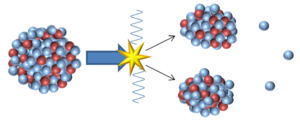Difference between revisions of "Nuclear Fission"
(→Key Stage 5) |
|||
| (3 intermediate revisions by the same user not shown) | |||
| Line 41: | Line 41: | ||
====OCR==== | ====OCR==== | ||
:[https://www.amazon.co.uk/gp/product/0198359837/ref=as_li_tl?ie=UTF8&camp=1634&creative=6738&creativeASIN=0198359837&linkCode=as2&tag=nrjc-21&linkId=3c4229e8b023b2b60768e7ea2307cc6f ''Nuclear fission, pages 184-185, Gateway GCSE Physics, Oxford, OCR ''] | :[https://www.amazon.co.uk/gp/product/0198359837/ref=as_li_tl?ie=UTF8&camp=1634&creative=6738&creativeASIN=0198359837&linkCode=as2&tag=nrjc-21&linkId=3c4229e8b023b2b60768e7ea2307cc6f ''Nuclear fission, pages 184-185, Gateway GCSE Physics, Oxford, OCR ''] | ||
| + | |||
| + | ==Key Stage 5== | ||
| + | ===Meaning=== | ||
| + | '''Fission''' is the splitting of a heavy [[Atomic Nucleus|nucleus]] into two approximately equal fragments, releasing [[energy]]. | ||
| + | |||
| + | ===About Fission=== | ||
| + | *'''Nuclear fission''' can be spontaneous or induced by the absorption of a [[neutron]]. | ||
| + | *When [[Uranium-235]] or [[Plutonium-239]] absorbs a [[neutron]], it becomes unstable and splits into two smaller daughter [[Atomic Nucleus|nuclei]] along with additional [[neutron]]s and a large amount of [[energy]]. | ||
| + | *The released [[neutron]]s can induce further [[Nuclear Fission|fission]] reactions, leading to a [[Chain Reaction|chain reaction]]. | ||
| + | {| class="wikitable" | ||
| + | |- | ||
| + | |[[File:InducedFission.png|center|600px]] | ||
| + | |- | ||
| + | | style="height:20px; width:600px; text-align:left;" |A [[model]] showing a possible mechanism for induced '''nuclear fission''' resulting from the capture of a [[Thermal Neutron|thermal neutron]]. | ||
| + | |||
| + | <math>{}_{92}^{235}U + {}_{0}^{1}n \rightarrow {}_{92}^{236}U \rightarrow {}_{36}^{85}Kr + {}_{56}^{148}Ba + 3{}_{0}^{1}n</math> | ||
| + | |} | ||
| + | *'''Fission''' releases a significant amount of [[energy]], primarily in the form of [[Kinetic Energy|kinetic energy]] of the [[Nuclear Fission|fission]] fragments. | ||
| + | *'''Fission''' is used in [[Nuclear Reactor|nuclear reactors]] to generate [[electricity]] and in [[Nuclear Bomb|nuclear weapons]]. | ||
Latest revision as of 10:33, 30 May 2024
Contents
Key Stage 4
Meaning

An model of nuclear fission.
Nuclear fission is a process in which a large unstable nucleus splits into two more stable nuclei.
About Nuclear Fission
- Nuclear fission occurs when a massive nucleus is so unstable that it splits in two.
- During nuclear fission neutrons are also emitted.
- Nuclear fission transfers energy from the nuclear potential energy store into the thermal energy store of the material and the surroundings.
- In a nuclear fission reaction the products have less mass than the reactants as some of the mass is converted into energy in the process due to the Mass-Energy Equivalence.
- Nuclear fission can be induced in a material by bombarding massive nuclei with neutrons. If a neutron is captured by the nucleus it becomes so unstable that it splits in two.
- The neutrons used to induce fission must have a low energy to be captured by a nucleus otherwise the neutrons will just pass straight through without being captured. Neutrons with the right amount of energy to be captured are called thermal neutrons because they have a similar energy to molecules in the air at room temperature.
| A model showing a possible mechanism for induced nuclear fission resulting from the capture of a thermal neutron.
\({}_{92}^{235}U + {}_{0}^{1}n \rightarrow {}_{92}^{236}U \rightarrow {}_{36}^{85}Kr + {}_{56}^{148}Ba + 3{}_{0}^{1}n\) |
- If there is enough of an unstable isotope in a material a single nuclear fission can trigger a nuclear chain reaction in which the neutrons produced from the initial fission event can cause the fission of more than one other unstable isotope.
- A nuclear fission chain reaction is used in both nuclear bombs and nuclear reactors in nuclear power stations.
References
AQA
- Nuclear fission, page 140, GCSE Physics; The Complete 9-1 Course for AQA, CGP, AQA
- Nuclear fission, page 49, GCSE Physics; The Revision Guide, CGP, AQA
- Nuclear fission, pages 104-105, GCSE Physics; Third Edition, Oxford University Press, AQA\
- Nuclear fission, pages 106-7, GCSE Physics, Hodder, AQA
Edexcel
- Nuclear fission, page 166, GCSE Combined Science, Pearson Edexcel
- Nuclear fission, page 22, GCSE Chemistry, Pearson, Edexcel
- Nuclear fission, page 57, GCSE Physics; The Revision Guide, CGP, Edexcel
- Nuclear fission, pages 110, 112-113, GCSE Physics, Pearson Edexcel
- Nuclear fission; power generation, page 113, GCSE Physics, Pearson Edexcel
OCR
Key Stage 5
Meaning
Fission is the splitting of a heavy nucleus into two approximately equal fragments, releasing energy.
About Fission
- Nuclear fission can be spontaneous or induced by the absorption of a neutron.
- When Uranium-235 or Plutonium-239 absorbs a neutron, it becomes unstable and splits into two smaller daughter nuclei along with additional neutrons and a large amount of energy.
- The released neutrons can induce further fission reactions, leading to a chain reaction.
| A model showing a possible mechanism for induced nuclear fission resulting from the capture of a thermal neutron.
\({}_{92}^{235}U + {}_{0}^{1}n \rightarrow {}_{92}^{236}U \rightarrow {}_{36}^{85}Kr + {}_{56}^{148}Ba + 3{}_{0}^{1}n\) |
- Fission releases a significant amount of energy, primarily in the form of kinetic energy of the fission fragments.
- Fission is used in nuclear reactors to generate electricity and in nuclear weapons.
